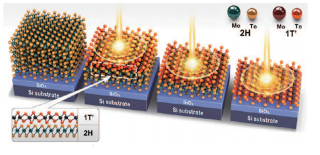Aug 11 2015
A multi-disciplinary research team had developed a fabrication technique for creating pure molybdenum ditelluride (MoTe2) last year. The team not only succeeded in developing pure MoTe2, it also was able to obtain two varieties – semiconducting and metallic.
 A simulation of the process of converting the 2H-MoTe2 into 1T'-MoTe2 with laser-irradiation
A simulation of the process of converting the 2H-MoTe2 into 1T'-MoTe2 with laser-irradiation
The semiconducting type was termed as 2H-MoTe2 (2H due to its hexagonal shape) and the metallic type was termed as 1T'-MoTe2 (1T’ as it has an octahedral shape). Both these varieties exhibited stability at room temperature.
The research team was headed by Director Young Hee Lee from South Korea’s Institute for Basic Science (IBS) Center for Integrated Nanostructure Physics at Sungkyunkwan University (SKKU).
MoTe2, in its purest form, can find application as a transistor. Its atomic structure includes one molybdenum atom for every two tellurium atoms [HY1]. The compound was first created in the 1960s using a range of fabrication techniques. However, until last year, the compound created was not pure enough to be used in electronic applications.
Making MoTe2 in a pure form was highly challenging. This compound was considered by some researchers as a black sheep in the transition metal dichalcogenides (TMD) group, and was purposely neglected. TMD molecules can be developed as ultrathin material consisting of just several atomic layers. They also possess a band gap, rendering them suitable for fabricating electronic components such as transistors.
The format adopted by a TMD crystal is an MX2 format – it has one transition metal denoted by M and two chalcogenides denoted by X2. Transition metals include tungsten, molybdenum and the like, and chalcogenides include sulfur, selenium and the like. One metal and two chalcogenides create a thin molecular sandwich. These atoms are capable of existing in differently shaped atomic structures based on their fabrication technique.
The large number of microchips in electronics is presently made of silicon and they work perfectly. The reducing device size, however, has been increasing the demand for bringing down the size of logic chips behind those devices. While shrinking the chips to single- or several-atom thickness, normally known as two-dimensional, silicon does not work perfectly as in a three-dimensional or a 3D scale.
With the scale approaching 2D, there is a variation in silicon’s band gap, which is more than its 3D form. The contact points made of silicon metal connections are not smooth enough for effective use in electrical circuits.
This is the ideal opportunity for using novel and exotic TMD materials. The IBS researchers were able to successfully use the two MoTe2 versions and create a single 2D crystal having semiconducting 2H-MoTe2 and the metallic 1T'-MoTe2. This structure is better than silicon and also other 2D semiconductor due to the presence of the so-called ohmic homojunction at the boundary, where the semiconducting MoTe2 meets with the metallic MoTe2.
This is a connection that is created at the junction between two distinct structural phases in a single material. Although MoTe2 had two different states – metallic and semiconductor, the team could form an ohmic junction, thus attaining a very tough connection.
For achieving this, the team used pure 2H-MoTe2 that has a thickness of several atoms. A 1µm wide laser was focused at the 2H-MoTe2, which heated the sample locally and modified the impacted area into 1T'-MoTe2. To understand the dimension of the laser involved, a human hair thickness is 17 to 181µm thick. The researchers used this technique to develop a transistor, which combined the high conductivity of 1T'-MoTe2 and the semiconducting of the 2H-MoTe2 material.
This is a very smart solution in comparison to the challenges that have hindered engineers and scientists previously. The device is also energy-efficient as a single material is used in the metal-semiconductor junction and the device channel. This happens because there is a seamless fusion between the two MoTe2 phases, causing an ohmic contact at the joints. It is possible to directly apply metal electrodes to 1T’-MoTe2 due to its excellent conductivity, thus saving the labor of devising a way to fit metal leads. This novel fabrication method is an excellent way of using available MoTe2 without extraneous or wasted parts.
When Professor Heejun Yang of SKKU was questioned about its future application potential, he stated “There are many candidates for 2D semiconductors, but MoTe2 has a band gap of around 1eV which is similar to silicon’s band gap and it allows an ohmic homojunction at the semiconductor-metal junctions.”
Therefore, silicon can be substituted with MoTe2 without considerably changing the existing voltage configurations employed in current silicon technologies. With an increasing demand for smaller, lighter and energy-efficient materials, the dual-phase MoTe2 transistor is promising for use in novel electronic devices.